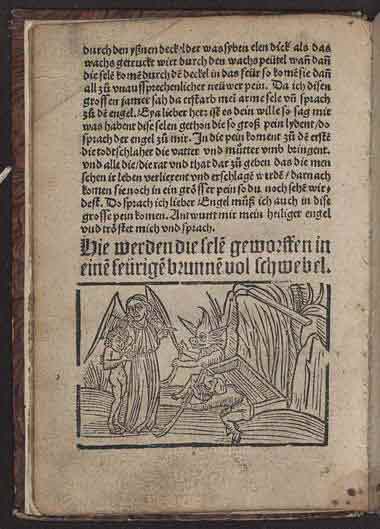Visio Tnugdali
The Visio Tnugdali (Latin for " Vision of Tnugdalus " ) is reported a religious text from the 12th century, the (later simplified " Tundalus " or " Tondolus " ) from the Beyond Vision of the Irish knight Tnugdalus.
Shortly after 1149 wrote Irish monk brother Marcus in Scots monastery at Regensburg in Latin prose the vision report down. The year he calls himself as the timing of the rapture of the Tundalus. Marcus indicates, to have translated from Irish and written at the request of Regensburg abbess the experiences of Tundalus, which he claims to have heard from him.
Content
The Legend story tells how the proud and easygoing knight suddenly falls in catalepsy and is three days long as there dead. During this time, his soul is guided by an angel through hell and heaven and has to suffer some punishment in hell itself. Finally, the angel given him the order to the seen good to remember and proclaim his fellow man. Then the soul is sent back to her body. Through the experience of this hike Beyond Tundalus is converted and turns away from his unchristian behavior in order to lead a pious life.
The Visio shows a remarkable assessment of the myths of Ireland: The two legendary hero Conall and Fergus mac Cernach Róich must serve for all eternity as jaw locks in his huge mouth here in the " Hell of the Ravenous " the soul -eating monster Acharon.
The Visio Tnugdali with her interest in the topography of the Hereafter is available in a wide tradition of fantastic Irish otherworld journey tales ( Imrama ) on one side; the most famous is likely the Navigatio Sancti Brendani of St. Brandan be an already Christianized expression of Imrama - narrative type ( travel to the Otherworld ). On the other hand there is the tradition of Christian afterlife visions, which in turn is influenced by pre-Christian beliefs in an afterlife. Important texts from this tradition are in addition to the Visio Tnugdali about the Visio Thurkilli that Visio Godeschalci or the Tractatus de Purgatorio Sancti Patricii.
Reception history
The Latin Tundalus quickly found wide handwritten dissemination; so far 172 manuscripts have been discovered. The text was also a template for medium low and medium high German edits; even from the 12th century come the rhymed version of the Tundalus of Alber monastery Wind Mountain ( around 1190 ) or the Lower Rhine Tundalus fragments ( 1180 /90). Both Middle High German transmissions, however, seem not to have found a great response; they are each only survived in a single manuscript (or in fragments of a manuscript ).
In the early modern period the submission of Marcus was several times translated into German and printed. The 40 surviving manuscripts and early printed 27 show that the Visio Tnugdali was at least twelve times translated into German and Dutch.
The vision was illustrated rather rare. Of the manuscripts contains only one Illustrations (Simon Marmion, 1474 ), but found in the early editions, some woodcuts.


_-_The_Beast_Acheron_-_Google_Art_Project.jpg)
_-_Tondal_Suffers_a_Seizure_at_Dinner_-_Google_Art_Project.jpg)






